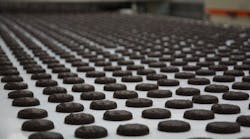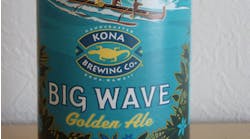Ready to put his Purdue University degree to work, Dave Van Laar, dug into one of his first assignments as an industrial engineer: to cost-justify the purchase of a cardboard bailer. "When I did the initial justification, we were going to make $10,000 a year selling the cardboard scrap. But by the time we got it purchased and installed, the board market had changed so much we had to pay someone to haul it off."
That was the 1970s. Since then the board market has changed. A lot. Also since then, Van Laar's career took off with operations and management positions leading him to baking companies including Pepperidge Farm and ultimately, Oak State Products, a Wenona, Ill.-based contract baker of cookies and bars. As president and CEO at Oak State, he again presides over a compacting-and-baling operation that is decidedly more profitable than using open-top containers and loose hauling of waste. One truck does the work of seven, eliminating an annual 213 truckloads and 6,390 gallons of diesel a year to save him $44,730.
"We're saving fuel, we're saving transportation costs, and we're also eliminating trips to the landfill," he says, adding that one of the company's goals is "zero landfill" by 2013. To help him reach that goal, the company also is bumping up recycling and vendor packaging reductions.
Another company shares the same zero-landfill dream: that granddaddy of the supply chain, Walmart. Picking through its waste stream, literally and figuratively, to donate usable goods and streamline its suppliers' packaging materials, the company reduced its landfill load more than 80 percent; a national rollout is now planned.
"You go through your P&L," Bill Simon, president and CEO of Walmart U.S., said at the company's Global Sustainability Milestone Meeting in March, "and you see this big line that's called 'waste removal' and it's a negative charge." Through commitment analysis and teamwork, "that line, that was a big negative on our P&L, is now turning into actually a fairly large positive."
Anyone doing business with Walmart or any company with global brand recognition knows that environmental sustainability isn't just a marketing ploy. It's a prerequisite for doing business -- as well as a mandate, and opportunity, to make wise capital investments. The environmental aspect of sustainability, alongside financial and corporate responsibility initiatives, is prominent on Wall Street and tracked in the Dow Jones, Ethibel and other sustainability indexes.
Another index, Walmart's Sustainability Index (http://walmartstores.com/Sustainability/9292.aspx), hits lesser-known companies who rank among the mega-retailers’ 100,000-plus suppliers now subject to sustainability assessments, measurements and improvements. Walmart requires suppliers not only reduce their own carbon footprint, but ensure that their own suppliers are in line with those efforts. This includes ingredient and material suppliers as well as, say, contract bakers.
Oak State's profitable sustainability
Oak State Products had been working on sustainability "for several years because it was the right thing to do," says Van Laar. "As we did that, we found it also became the profitable thing to do."
In addition to its landfill reduction efforts, Oak State has made investments in several areas:
- Electricity: A switch to high-efficiency fluorescent T5 and T8 lighting saved the company an annual 1 million-plus kilowatt hours for a 45 percent reduction in operating costs and a one-year payback. Motors continue to be replaced as needed with "the highest-efficiency motors we can get," says Van Laar, which is a "no brainer" in light of advances in technology.
- Natural gas: Usage gauges, burner efficiency tests, meters on individual zones and data loggers as well as tuning individual oven burners "give us a better handle on what we're using per zone," says Van Laar. Tuning burners has improved burner efficiency by 10 percent. Oven exhaust and heat recapture and reuse may be in the cards.
- Water: Reductions in consumption include a switch from using water for cleaning to dry cleaning and sanitizing as much as possible. A wastewater treatment project is underway targeting biological oxygen demand reduction to less than 200 mg/L.
Oak State's environmental efforts gained steam when one large customer who had requirements to meet, in turn, helped the bakery along the way.
"From there it just took off to looking at everything in the plant," Van Laar says.
Such assistance from larger companies is commonplace, according to Walt Tunnessen, national program manager for the U.S. Environmental Protection Agency's Energy Star program for Industry. He says large companies in the program have been "very active" in mentoring others in their journey into compliance and sustainability.
Oak State's sustainability efforts earned the company an Energy Star certificate in 2010 that has proved to be a "huge boost," says Van Laar, noting that customers familiar with the company "don't even ask us about sustainability anymore. They know we 'get it,' that we know what we're doing and we get it done," he continues.
The marketing value of brandishing an Energy Star logo is just an echo of the operational and financial benefits gained, because being "green" in public is a result, not the cause, of significant operational efficiency improvements. Oak State's example is as inspiring as -- perhaps more so than -- the efforts of industry giants, because the single-plant company shows that you don't have to be PepsiCo to be – to borrow a term – an Energy Star.
Energy Star provides the tools
Under Energy Star's industry partnership program, companies that reduce energy consumption 10 percent over five years or less can become an Energy Star Partner and earn certification and rights to promote the Energy Star logo in company materials.
"It doesn't cost much to do that," says Tunnessen, "and an energy program will pay for itself. Companies just need to make energy savings a priority, put people in place, have the CEO empower those people and they’re going to save you money. And you’re not shooting in the dark; there’s someone there to show you how to do it."
The good news for those who can't undertake massive engineering projects is that improvements can be made incrementally. Savings can come one project at a time, from lighting upgrades to sealing compressed-air leaks to conserving water. And when equipment goes in, make it high-efficiency.
Even the smallest gestures can add up – such as Oak State’s suggestion boxes, which have volunteered tips on "everything from leaky faucets to getting rid of styrofoam cups." Probably 50 suggestions have been acted upon, Van Laar says.
Even as he promotes the many success stories regarding profitable energy-related projects, Energy Star's Tunnessen cites the importance of taking other companies' claims "with a grain of salt." Factors ranging from the age and efficiency of existing assets and varying utility rates can change a company's cost-saving calculations. "What is cost-effective in New Jersey may not be cost-effective in Montana," he notes. The only way to justify the cost of environmental upgrades is to crunch the numbers.
Through the experience of Oak State and other bakers, the Biscuit & Cracker Manufacturer's Association (www.thebcma.org) in partnership with Energy Star produced a Cookie and Cracker Baking Energy Performance Indicator (EPI). Released in 2010, the spreadsheet-based tool lets U.S. bakeries evaluate their energy efficiency; set goals to improve efficiency; reduce costs and greenhouse gas emissions; and earn Energy Star certification. It also enables bakeries to compare their energy performance to similar bakeries operating in the U.S.
The tool is based on industry data reported to the U.S. Census Bureau, developed in partnership with B&CMA and tested and validated by cookie and cracker bakeries, including Oak State Products. It can be found and downloaded from links at B&CMA's Web site as well as the Energy Star Focus on Energy Efficiency in Food Processing (http://www.energystar.gov/index.cfm?c=in_focus.bus_food_proc_focus). The site includes tools for food & beverage industry plants, typically created when a leader in a product segment steps forward to help create one, as Oak State did for cookies and crackers – more will come when you get involved.
The latest news in baking efficiency is that this fall, the American Bakers Association (www.americanbakers.org) unveils its own Energy Star partnership program, which will broaden the existing Energy Star tools for bakers. Some of the impetus came from a presentation Oak State's Van Laar gave in March at the technical conference of the American Society of Baking (www.asbe.org), plus subsequent meetings between ABA's sustainability committee and Oak State as well as Energy Star.
Greater environmental efficiency "is going to affect bakers' bottom line," according to Rasma Zvaners, policy director and staff liaison for ABA’s Energy & Environment. She cites electric and gas use, water use and also waste and recycling as "things that are working in plants today, and having an impact on the bottom line."
Supporters of Energy Star point out that efforts span the life cycle of a plant, including new construction and expansions built in accordance with the U.S. Green Building Council's Leadership in Energy & Environmental Design (LEED) certification programs for new and/or existing buildings. LEED has traditionally been focused on sustainability in a broader sense, whereas Energy Star is focused more narrowly energy performance. The two programs are complementary, Tunnessen explains: "We’ve even talked about potentially using the Energy Star ratings for industry as part of the LEED certification standard."
Ultimately, all major initiatives require commitment form the top down. This isn't a problem for Oak State, whose CEO has the heart of an engineer. Van Laar, presenting to bakery groups, offers advice to those wondering how they can help along their own energy savings programs. Beyond participation in industry efforts like those he helps lead at B&CMA, Van Laar says his company's sustainability efforts have been succeeding on the strength of "dramatic" acceptance throughout the corporate culture.
"Obviously, our program has support from the top, but we also have a resource conservation team on each shift. They meet weekly. They go through the plant and look for energy saving opportunities and talk to fellow employees. We put signs up, we do T-shirts with them, we do all kinds of things to keep the effort alive and let everyone know they've got support from top to bottom," the CEO says, citing "dramatic" cultural change and adoption.


